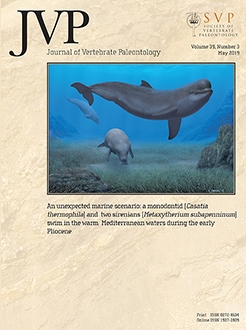Stegosiren macei, a new genus and species of halitheriine dugongid from the mid-Oligocene of South Carolina, U.S.A. (Ashley and Chandler Bridge formations, late Rupelian–late Chattian), represents a stage of halitheriine evolution more derived than that of the Old World early Oligocene Eosiren imenti and Halitherium schinzii, but slightly less derived than the West Atlantic late Oligocene Metaxytherium albifontanum. It is more comparable in stage of evolution to its early Oligocene contemporaries Caribosiren turneri and Priscosiren atlantica and may be a sister taxon of these two. It is distinguished autapomorphically from all other sirenians by a notably broadened frontal roof and a thickened anterior tip of the frontal, which formed a butt joint with the premaxilla. Analogous (independently evolved) joints in several other sirenians (principally dugongines) are correlated with enlarged upper tusks thought to be used for excavating seagrass rhizomes. This suggests that large tusks also may have been present (although not preserved) in Stegosiren, which is only the second halitheriine in which such a feature has been observed. Stegosiren macei brings to at least seven the number of potentially sympatric sirenian species lineages known from the West Atlantic-Caribbean Oligocene (six or more from South Carolina alone). This extraordinary sirenian diversity, unmatched elsewhere in the world, poses problems for ecomorphology and feeding-niche partitioning.
How to translate text using browser tools
24 October 2019
Fossil Sirenia of the West Atlantic and Caribbean Region. XII. Stegosiren macei, gen. et sp. nov.
Daryl P. Domning,
Brian L. Beatty
ACCESS THE FULL ARTICLE





